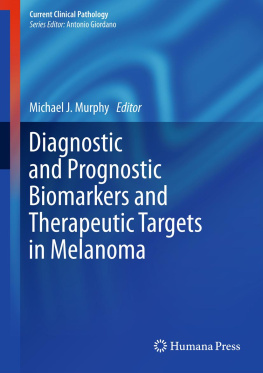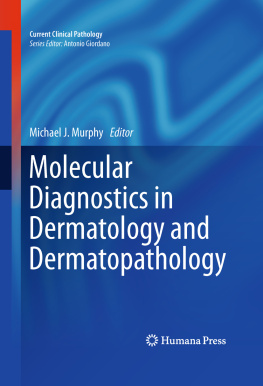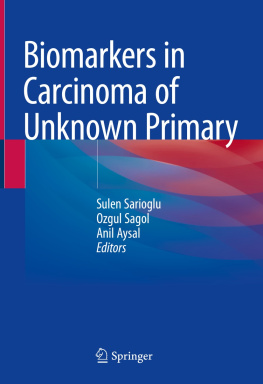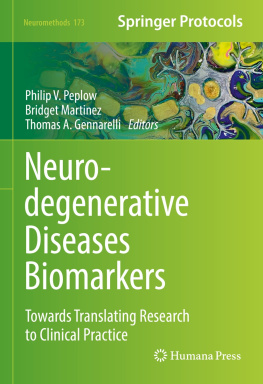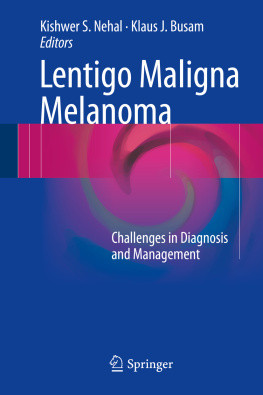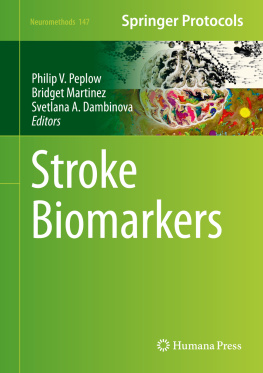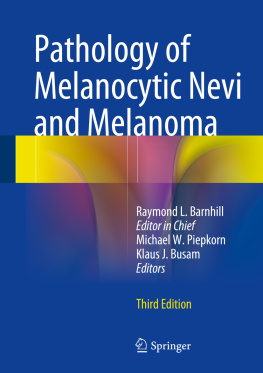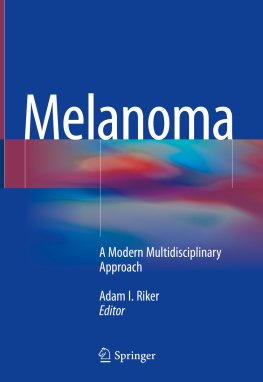Michael J. Murphy (ed.) Current Clinical Pathology Diagnostic and Prognostic Biomarkers and Therapeutic Targets in Melanoma 10.1007/978-1-60761-433-3_1 Springer Science+Business Media, LLC 2012
1. Introduction to Diagnostic and Prognostic Biomarkers and Therapeutic Targets in Melanoma
The aim of this book is to discuss both the technologies used in the discovery of melanoma biomarkers and the clinical application of these biomarkers for diagnosis and staging of disease, determination of prognosis, prediction of drug response, monitoring the efficacy of therapy, identification of novel therapeutic targets, and drug development. A broad range of biomarkers [described as any measurable molecular alteration within a cancer cell (i.e., DNA/chromosomal, mRNA, microRNA, mitochondrial DNA, epigenetic and protein)] is outlined. Of note, individual/panels or patterns of molecular markers may now be employed to stratify microscopically-similar melanocytic tumors into subsets with different biological behaviors and outcomes []. An important goal is the enhancement of both safety and efficacy of melanoma management by facilitating the tailoring of treatment(s) to individual patients (personalized medicine). Novel biomarkers could be used to distinguish patients with melanomas requiring targeted intervention from those individuals who require no further therapy. Some of these biomarkers may also have a role in cancer screening, early detection and/or risk assessment. In this regard, current high-throughput laboratory technologies have facilitated the discovery and validation of biomarkers in patients with melanoma; although, efforts are still hampered by some of the limitations of currently available methodologies. The ideal biomarker should be sensitive, specific, rapidly analyzable, reliable, cost-effective, and demonstrate clinical relevance beyond traditional gold-standard clinical and histopathological data available at the time of diagnosis and/or follow-up. Despite some notable discoveries, the translation from bench-to-bedside has been slow and the number of biomarkers validated for use in the management of patients with melanoma remains limited. It is likely that further advances in genomic and proteomic technologies and bioinformatics will lead to the identification of additional clinically-useful biomarkers for disease classification, staging, prognostication, treatment selection, and monitoring of therapeutic response, in addition to novel drug target discovery and facilitation of drug development.
Melanoma is considered an epidemic cancer as its worldwide incidence has increased 697% between 1950 and 2000, faster than that of any other cancer subtype; although, recent evidence suggests that this rise may have peaked []. While representing <7% of all skin malignancies, melanoma is the most lethal cutaneous malignancy and accounts for 75% of all deaths from skin tumors.
The TNM staging categories and groupings of the updated 2009 American Joint Committee on Cancer (AJCC) Melanoma Staging System are outlined in ].
Research is on-going into the molecular mechanisms that underlie the malignant transformation of melanocytes to melanoma and the progression of primary cutaneous tumors to invasive and metastatic disease. Significant progress has been made in our understanding of the cellular, molecular and genetic basis for melanoma. The traditional classification of melanoma into four subtypes (i.e., acral lentiginous, superficial spreading, nodular, and lentigo maligna), which is based on clinical-histopathological features, is now being challenged by the results of molecular studies [].
As stated previously, numerous molecular biomarkers, which highlight the mechanisms of melanoma pathogenesis and progression, have been identified [].
The alkylating agent dacarbazine (DTIC) is the only FDA-approved chemotherapeutic agent for treatment of metastatic melanoma; although, responses are infrequently seen (510% of patients) and are generally short-lived []. Because current therapy for advanced melanoma utilizes cytotoxic agents and biological response modifiers that mediate tumor regression by different mechanisms, combined testing for multiple genetic polymorphisms could potentially generate more accurate pharmacogenomic information than single SNP analysis.
The mitogen-activated protein kinase (MAPK) signaling pathway (RAS/RAF/MEK/ERK) has been found to be constitutively activated in up to 8090% of melanomas [].
Imatinib mesylate, a tyrosine kinase inhibitor of BCR-ABL, KIT and PDGFR, is an FDA-approved treatment for both chronic myelogenous leukemias (which harbor the BCR-ABL fusion protein) and gastrointestinal stromal tumors (GISTs; which harbor oncogenic KIT and/or PDGFRA mutations) []. These findings clearly illustrate the importance of proper patient selection prior to imatinib treatment, including KIT and PDGFRA gene mutational analysis. With this in mind, a number of multicenter Phase II clinical trials, using imatinib, in addition to sunitinib, nilotinib, and dasatanib, for the treatment of metastatic melanomas with KIT genomic aberrations (i.e., from acral, mucosal, and chronically sun-damaged sites) have been initiated.
Many treatment-responsive patients ultimately relapse as a result of acquired resistance to selective kinase-targeted therapies. This may be due to a number of factors, including re-establishment of negative feedback and/or alternative activation of MAPK signaling, other BRAF mutations or amplifications, mutations in RAS (HRAS, KRAS, or NRAS) or MEK1 genes, or activation of alternative pathways that drive proliferation, resistance to apoptosis or tumor escape (PI3K-AKT, CMET, KIT, FGFR, and EGFR) [].
Melanoma tumors can demonstrate spontaneous immune-mediated regression [].
In the future, molecular technologies could be used to determine pathway activation and indicate which combinations of drugs would be most effective in an individual patient with melanoma. For example, the employment of laser capture-microdissection to isolate both melanoma cells and normal-appearing surrounding tissue would facilitate gene expression profiling and genotyping for both germline aberrations and somatic mutations (i.e., those acquired by melanoma cells) in routine surgical specimens. Disease outcome may depend on a combination of both the inherited germline and tumor genomes. Determination of germline DNA alterations could be used to assess the host baseline pharmacogenomic profile. This strategy could have important consequences for clinical trial design, with the incorporation of pharmacogenomics into inclusion (and exclusion) criteria. Previous studies of targeted drugs may have failed in part because of inadequate melanoma characterization, resulting in the inclusion of few to no potentially treatment-responsive patients.

